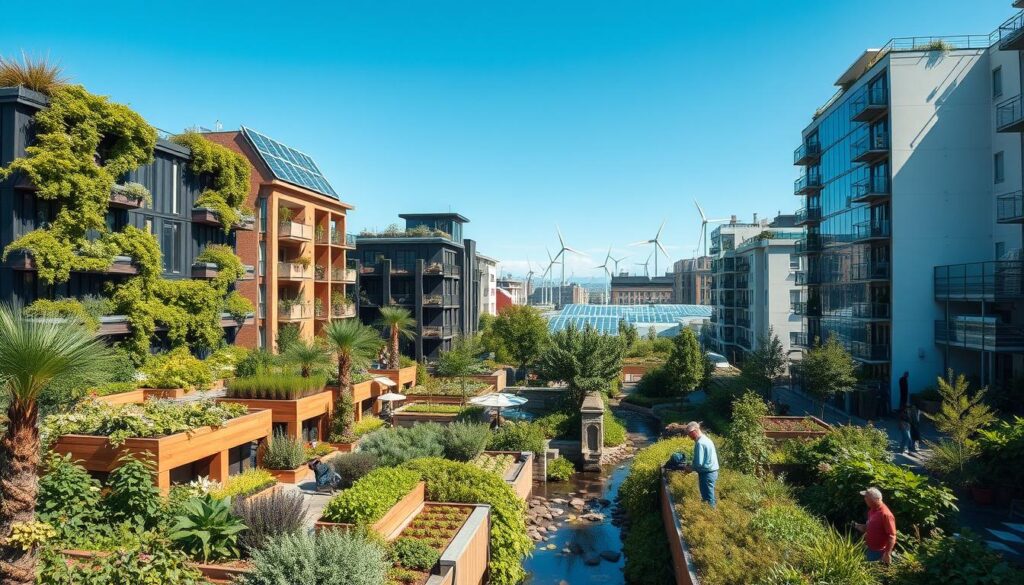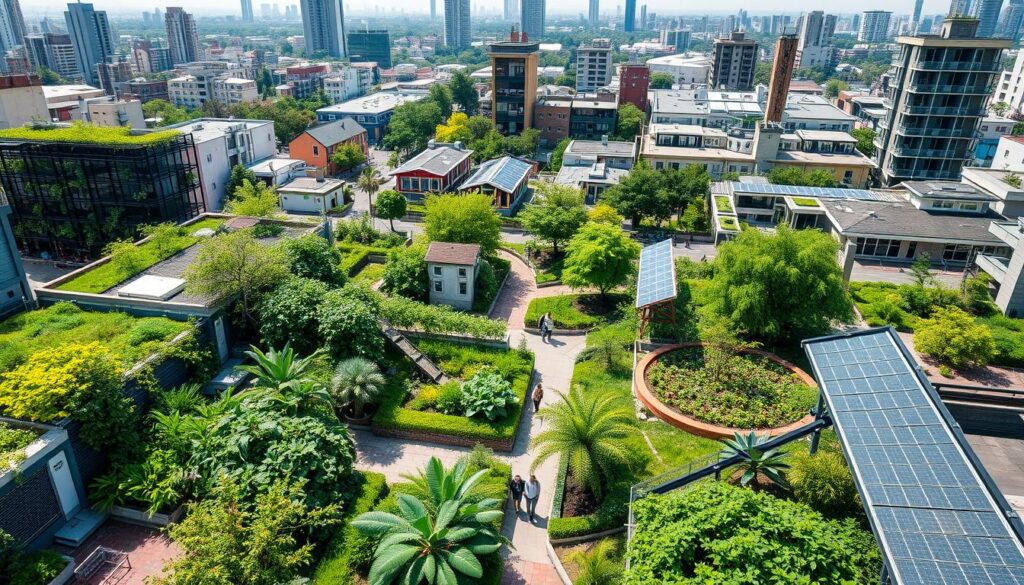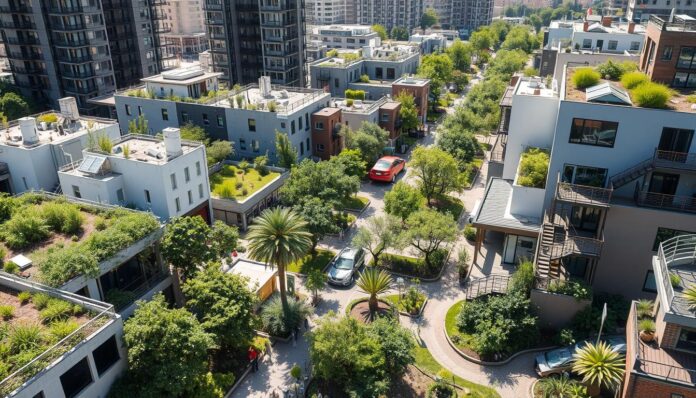Permaculture urban planning is a way to design cities that are good for the planet. It helps make cities more eco-friendly and strong. By using permaculture, urban planners can make cities that are good for people and the environment.
Urban permaculture projects aim to use no chemicals in gardening. They focus on organic gardening and growing food without harming the planet. For example, using 52 windows for a greenhouse and a rainwater system shows how permaculture can be applied in cities.
Experts like Peter Bane have over 20 years of experience in permaculture. They help cities use sustainable design and permaculture. This improves food security and makes communities stronger.
The Permaculture Handbook is a great resource for urban planners and permaculture fans. It shares success stories from farms and gardens. It helps promote permaculture in cities and sustainable design.
Introduction to Permaculture Urban Planning
Permaculture urban planning is about designing cities that work like nature. It makes cities better for the environment and people. By using permaculture, cities can become more sustainable and regenerative.
Key Takeaways
- Permaculture urban planning is a holistic approach to designing sustainable human environments.
- Sustainable urban design and urban permaculture can lead to more eco-friendly and resilient cities.
- Reducing chemical usage in gardening to zero is a key principle of permaculture urban planning.
- Creating abundance while reducing dependence on fossil fuels is a primary goal of permaculture.
- Permaculture experts like Peter Bane can provide valuable guidance on adopting sustainable urban design and urban permaculture principles.
- The Permaculture Handbook is a valuable resource for urban planners and permaculture enthusiasts.
Understanding Permaculture in Urban Environments
More than 55% of the world’s population now lives in cities. This makes eco-friendly city planning and urban sustainability more urgent than ever. Green infrastructure in cities is key to cutting carbon emissions and improving health. Permaculture, a design system, aims to create sustainable habitats by mimicking nature.
The three core ethics of permaculture are Earth Care, People Care, and Fair Share. These ethics guide urban planners in designing sustainable cities. For instance, Melbourne has seen a big drop in carbon emissions thanks to its urban permaculture efforts.
- Reduced carbon emissions
- Promoted biodiversity
- Increased social cohesion
- Improved air and water quality
As cities expand, the need for sustainability and green infrastructure will grow. By adopting permaculture, we can build a greener, more sustainable future for all.
Key Principles of Permaculture Design
Permaculture design focuses on several key principles. These aim to create sustainable urban environments and promote green agriculture. The main principles include observing and interacting with nature, catching and storing energy, and producing no waste.
Observe and Interact
Understanding and working with nature is key in permaculture. It involves learning the natural patterns and processes in an ecosystem. This knowledge helps design systems that work with nature, not against it.
Catch and Store Energy
Catching and storing energy is another important principle. It uses methods like rainwater harvesting and solar power. These techniques help reduce the need for outside resources and promote sustainability.
Produce No Waste
Creating systems that produce no waste is a core principle. This means using methods like composting and recycling. It helps minimize waste and promotes a more sustainable environment.
Permaculture design offers many benefits:
- Increased biodiversity
- Improved soil health
- Reduced water usage
- Increased food production

By following these principles, permaculture design can lead to sustainable urban development. It promotes green agriculture and helps create a more resilient future.
| Principle | Benefit |
|---|---|
| Observe and Interact | Understanding natural patterns and processes |
| Catch and Store Energy | Reducing external inputs and promoting sustainability |
| Produce No Waste | Minimizing waste and promoting recycling |
The Role of Community in Urban Permaculture
Community involvement is key in making sustainable city design and resilient urban landscapes a reality. When people work together, they can design and start permaculture projects that help everyone. For instance, creating local community gardens and working on projects together can lead to sustainable city design. It also builds a sense of cooperation and shared responsibility.
Some urban permaculture projects have been very successful. For example:
- The Beacon Food Forest in Seattle covers over seven acres for urban agriculture and community involvement.
- The Incredible Edible Todmorden project in the UK turned empty plots into community gardens.
Building Local Community Gardens
Community gardens unite people and create a sense of community. They also offer a place for learning and sharing skills, making urban areas more resilient. With more than 55% of the world’s population in cities, it’s crucial to make these places sustainable and resilient.
Collaborative Projects and Events
Working on projects and events together can strengthen community bonds and promote sustainable city design. These efforts also offer chances for learning and skill-sharing, enhancing the resilient urban landscape. By joining forces, community members can build a brighter future for themselves and the environment.
Assessing Urban Spaces for Permaculture
More than half of the world’s people live in cities now. By 2050, cities will be home to 68% of us. This makes permaculture urban planning crucial for green cities. We need to find unused areas, check soil and water, and link green spaces.
Using urban permaculture can make cities better for the planet and people. For example, it can cut down on water runoff by 60%. This helps keep soil moist and supports more native species.
Urban permaculture offers many benefits:
- More fresh food for city folks
- Less waste and better use of resources
- More wildlife and ecosystem services
- Stronger community bonds

By adding permaculture to city planning, we can make cities better. As cities grow, so will the need for urban permaculture and permaculture urban planning.
| Benefits of Urban Permaculture | Percentage Improvement |
|---|---|
| Reduced runoff | 60% |
| Increased biodiversity | 30% |
| Improved access to fresh produce | 40% |
Sustainable Water Management Techniques
The world’s population is growing fast, making eco-friendly city planning and urban sustainability key. We need to manage water better. Only 2.5% of the world’s water is freshwater, and even less is safe for us. We must find ways to cut down on stormwater runoff and make water cleaner.
There are many ways to manage water well. For example:
- Rainwater harvesting systems, which collect and store rainwater for non-potable uses
- Permeable surfaces, such as porous pavement, that allow rainwater to infiltrate the ground
- Contour and swale drainage, which involves creating small trenches to slow down water runoff and enhance water infiltration
These methods help reduce stormwater runoff and improve water quality. They cut down on pollutants in waterways. By using these techniques, urban planners can make cities more eco-friendly and sustainable. This helps fight floods and droughts, ensuring water for all living things.
Also, we can manage water sustainably with drought-tolerant plants, mulching, and keyline design. These methods lower water use and keep water in urban areas. By doing this, cities can face climate change better and ensure a green future for everyone.
Urban Agriculture: A Practical Approach
Urban agriculture is key in making cities sustainable. It brings fresh food, cleaner air, and cools down cities. This way of planning cities makes them better for people and the planet.
Techniques like vertical farming solutions and roof gardens and green roofs are used. They make the most of space and add green areas. These methods help cities be greener and teach people about growing food in the city.
Edible Landscapes for Communities
Edible landscapes turn urban areas into food-producing spaces. They make public and private areas grow food. This boosts food security and adds to urban biodiversity.
Urban agriculture is crucial for sustainable cities. It helps cities become greener and healthier. By using these methods, cities can become better places for everyone and the environment.
Integrating Native Plants in Urban Landscaping
Native plants offer many benefits. They improve air quality, cut down on stormwater runoff, and boost biodiversity. These are key for making cities better for both people and the planet.
Native plants need 30-50% less water than non-native ones. This makes landscaping more eco-friendly. Plus, they can make urban areas 50% or more more diverse, helping pollinators and wildlife.
To make native plants work in cities, plant them in groups. This helps them survive and supports wildlife. Water them well during their first year. After that, they can find water on their own thanks to deep roots. 
Using native plants in cities makes them stronger and more sustainable. It cuts down on the need for artificial lawn care and helps local ecosystems. It also cools cities down by 2-5 degrees Fahrenheit, thanks to more greenery and shade. This supports the growth of better cities.
Creating Urban Microclimates
Urban microclimates can be made using different methods. These include controlling temperature and using structures to improve conditions. This is key in sustainable urban design to fight the urban heat island effect, better air quality, and boost biodiversity. By using eco-friendly city planning ideas, cities can become more livable and green.
Creating urban microclimates involves using sheltered spots, like south-facing slopes, to extend growing seasons. Planting windbreaks can cut wind speed by 30-50%. Trees can also make areas up to 5 degrees Fahrenheit cooler. Water bodies or irrigation systems can raise humidity levels by up to 25%, helping plants that love moisture.
By using these methods, urban planners can make areas that support many plant and animal species. This can attract up to 40 different animal species in one area. It also helps protect about 75% of crops from late spring frosts. Creating urban microclimates is vital for sustainable urban design and eco-friendly city planning. It makes cities more livable, green, and diverse.
Permaculture Ethics in Urban Development
Permaculture ethics are key in making cities sustainable and regenerative. By using fair share and care for the earth and people, urban planners can build better cities. This way, cities can be more eco-friendly, fair, and connected.
For example, urban permaculture helps grow food and improve community life.
Some main advantages of permaculture in cities are:
- Less carbon footprint from local food and less travel
- More biodiversity and strong ecosystems
- Healthier minds and less stress from gardening together
By using permaculture in city planning, cities can be greener and stronger. As cities grow, the need for permaculture planning will grow too. It’s a way to care for both people and the planet in urban areas.
Case Studies: Successful Urban Permaculture Projects
Urban permaculture projects show how effective permaculture can be. They create green, thriving cities. By studying these projects, city planners can use permaculture to make their cities better.
New York City Urban Gardens
New York City’s gardens are a great example. They give fresh food to people and cool the city down. They also handle rainwater well.
Seattle’s Permaculture Initiatives
Seattle is working hard to be more green. Its projects help grow food, cut down waste, and support many species.
San Francisco Urban Agriculture
San Francisco is leading the way in food. Its farms and gardens give people fresh food and help the planet.
These examples show what permaculture can do. They inspire city planners to make their cities greener and stronger.
Policy and Permaculture: A New Paradigm
Permaculture urban planning is key for sustainable cities. It blends permaculture into zoning laws and pushes for urban farming policies. This makes cities greener and more eco-friendly.
Urban permaculture is changing how we build cities. It focuses on working with nature to reduce waste and energy use. Practices like managing stormwater and composting make sites more productive and cooler.
- Design sites to work with natural land contours for better stormwater management
- Use permaculture to make soil hold more water, cutting down on irrigation
- Create microclimates with crops and structures to control temperature and save energy
By using permaculture, cities can lessen their environmental footprint. They can also boost public health and build stronger communities. As more people move to cities, permaculture planning will become even more crucial.
Challenges in Implementing Permaculture
Starting permaculture in cities comes with big hurdles. Bureaucratic obstacles and community pushback are major ones. It’s key to tackle these to make cities better.
Urban permaculture projects often face:
- Strict legal rules on waste
- Not enough resources like money, time, and people
- Permaculture being misunderstood
But, we must find ways to make cities greener. This helps people and the planet. Urban planners can do this by getting more people involved and improving the environment.
By tackling these issues, we can make cities better for everyone. This is crucial for our health and the planet’s.
| Challenge | Solution |
|---|---|
| Bureaucratic hurdles | Collaboration with local authorities and policymakers |
| Community resistance | Education and awareness campaigns |
| Limited resource availability | Resource sharing and community engagement |
Future Trends in Urban Permaculture Planning
The world is getting more urban, and permaculture in cities is looking bright. New tech and design ideas are making urban food systems better. Tools like GIS and CAD help planners design sustainable cities that use resources wisely and support biodiversity.
Vertical farming is also changing city planning. It cuts down on water use, emissions, and waste. This method boosts food production in small spaces, helping cities feed their people better.
As more people move to cities, we need creative solutions like permaculture. By adopting these trends, cities can become green and thriving places for everyone and the environment.

